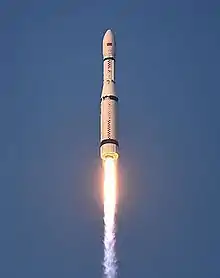Long March 6
The Long March 6 (Chinese: 长征六号运载火箭) or Chang Zheng 6 as in pinyin, abbreviated LM-6 for export or CZ-6 within China, is a Chinese liquid-fuelled launch vehicle of the Long March family, which was developed by the China Aerospace Science and Technology Corporation (CASC) [7] and the Shanghai Academy of Spaceflight Technology (SAST). The rocket was developed in the 2000s, and made its maiden flight in 2015.[8] As one of the new generation rocket family, the Long March 6 was designed to be a light capacity, "high-speed response" rocket, complementing the heavy lift Long March 5 and the mid-heavy lift Long March 7 rocket families. It is capable of placing at least 1,000 kg (2,200 lb) of payload into a Sun-synchronous orbit.[9][8] The first stage of the Long March 6 was derived from the booster rockets being developed for the Long March 5 rocket. It is powered by a YF-100 engine, which generates 1,340 kN (300,000 lbf) of thrust from burning kerosene and LOX as rocket fuel and oxidiser.[8] This was the first flight of the new engine design.[3]
 Maiden flight of Long March 6 rocket | |
| Function | Small launch vehicle |
|---|---|
| Manufacturer | Shanghai Academy of Spaceflight Technology [1] |
| Country of origin | China |
| Size | |
| Height | 29 m (95 ft) |
| Diameter | 3.35 m (11.0 ft) |
| Mass | 103,000 kg (227,000 lb) |
| Stages | 3 [2] |
| Capacity | |
| Payload to 700 km (430 mi) SSO | |
| Mass | 1,080 kg (2,380 lb) |
| Associated rockets | |
| Family | Long March |
| Comparable | Minotaur-C, PSLV-CA |
| Launch history | |
| Status | Active |
| Launch sites | Taiyuan, LA-16 |
| Total launches | 4 |
| Success(es) | 4 |
| First flight | 19 September 2015 [3] |
| Last flight | 6 November 2020 |
| First stage | |
| Diameter | 3.35 m (11.0 ft) |
| Propellant mass | 61,000 kg (134,000 lb) to 76,000 kg (168,000 lb) |
| Engines | 1 YF-100 |
| Thrust | 1,188 kN (267,000 lbf) [4] |
| Specific impulse | 300 seconds (sea level) 335 seconds (vacuum) [5] |
| Fuel | RP-1/LOX |
| Second stage | |
| Diameter | 2.25 m (7 ft 5 in) |
| Propellant mass | 15,000 kg (33,000 lb) |
| Engines | 1 YF-115 |
| Thrust | 180 kN (40,000 lbf) [4] |
| Specific impulse | 341.5 seconds (vacuum) [6] |
| Fuel | RP-1/LOX |
| Third stage | |
| Diameter | 2.25 m (7 ft 5 in) |
| Engines | 1 |
| Thrust | 6.5 kN (1,500 lbf) [4] |
| Specific impulse | 306.9 seconds |
| Fuel | N2O4 / UDMH[4] |
A boosted variant, with a payload of 4000 kg to Sun-synchronous orbit, is under development.
List of launches
| Flight number | Date (UTC) | Launch site | Payload | Orbit | Result |
|---|---|---|---|---|---|
| 1 | 19 September 2015 23:01 |
Taiyuan, LA-16 | ZDPS-2A, ZDPS-2B NS-2 ZJ-1, ZJ-2 Tiantuo 3 NUDT-Phone-Sat Xingchen 1, Xingchen 2, Xingchen 3, Xingchen 4 LilacSat 2 XY-2 DCBB Xiwang-2A, Xiwang-2B, Xiwang-2C, Xiwang-2D, Xiwang-2E, Xiwang-2F |
SSO | Success[8] |
| 2 | 21 November 2017 04:50 |
Taiyuan, LA-16 | Jilin 1-04/05/06 | SSO | Success |
| 3 | 13 November 2019 06:35 |
Taiyuan, LA-16 | Ningxia-1 01/02/03/04/05 | LEO | Success |
| 4 | 6 November 2020 03:19 |
Taiyuan, LA-16 | ÑuSat 9-18 (10 satellites) | SSO | Success |
See also
References
- "China conducts debut launch of Long March 6". NASASpaceflight. Retrieved 19 September 2015.
- "突破运力"下限"的长征6号" [Advances in Light Capacity Long March 6] (in Chinese). Tencent Military Channel. 19 December 2013. Retrieved 3 August 2015.
- The Long March 6 launched a 20-star in Taiyuan to create the best in Asia
- ZHANG Wei-dong, WANG Dong-bao (2016). "New Generation Cryogenic Quick Launching Launch Vehicle and Development". Aerospace Shanghai.
- "Chinese YF-100 (Russian RD-120) to Power CZ-5". SPACEPAC, The Space Public Affairs Committee. Retrieved 2 July 2015.
- "中国新一代液氧煤油发动机3:YF100/115主要特性 - 深空网". www.shenkong.net (in Chinese). Archived from the original on 4 March 2016. Retrieved 11 April 2016.
- "Development of China's new "Changzheng 6" carrier rocket commences". People's Daily Online. 4 September 2009. Retrieved 6 September 2009.
- "China conducts debut launch of Long March 6". 19 September 2015. Retrieved 20 September 2015.
- "Archived copy". Archived from the original on 18 September 2015. Retrieved 20 September 2015.CS1 maint: archived copy as title (link)